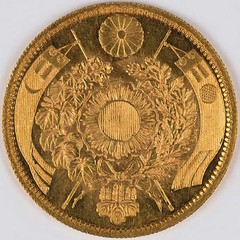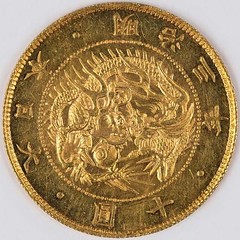
PREV ARTICLE
NEXT ARTICLE
FULL ISSUE
PREV FULL ISSUE
JAPANESE MEIJI PATTERN COIN DISCOVEREDYou never know when the next rare coin will come out of the woodwork. Here's the story of a great Japanese rarity discovered at routine appraisal. -Editor Toovey's Coins, Medals & Banknotes auction on January 19 got off to a storming start as the very first lot – a Japanese Meiji 10 yen Year 3 pattern gold coin from 1870 – demolished an estimate of £50,000- 80,000 to sell for £260,000 (plus 24.5% buyer's premium). It is currently one of only five known examples. Of the four others, one is in the Bank of Japan collection, another is in the British Museum and two were sold by Heritage Auctions in Dallas in 2011 and 2014. This large flan coin pattern, with a diameter of 32mm and a weight of 15.6g, dates from just two years after the Meiji Restoration brought Japan nominally back to imperial control. Under the New Currency Act of 1871, Meiji coins became standardised, smaller, round and identical (manufactured by Western machinery). They were known as yen – ‘small round object'. The 10 yen Year 3 pattern type was originally intended for general issue and was included in the new act. However, it was decided the relatively thin gauge would cause problems and a smaller diameter coin of the same weight was produced dated Meiji 4.
Discovered on a routine house clearance valuation appointment with a group of other gold coins at a local property, Toovey's example was described as George and his brother William Blizard the younger took over the company after their father's death. George deposited this coin with several others for some time at Lloyds bank in Worcester, incorrectly labelling it Chinese gold piece, suggesting that he was unaware of its full significance. The lot was contested by three phones and two room bidders in Washington, West Sussex. The majority of the bidding, however, was left to a room bidder acting for a client in China and a phone acting for a client in the US. It was the latter that won.
To read the complete article, see:
Wayne Homren, Editor The Numismatic Bibliomania Society is a non-profit organization promoting numismatic literature. See our web site at coinbooks.org. To submit items for publication in The E-Sylum, write to the Editor at this address: whomren@gmail.com To subscribe go to: https://my.binhost.com/lists/listinfo/esylum All Rights Reserved. NBS Home Page Contact the NBS webmaster 
|


